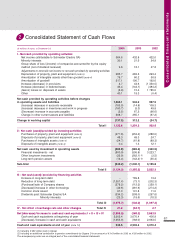APC 2004 Annual Report Download - page 70
Download and view the complete annual report
Please find page 70 of the 2004 APC annual report below. You can navigate through the pages in the report by either clicking on the pages listed below, or by using the keyword search tool below to find specific information within the annual report.
68
Interest rate swaps, which synthetically adjust interest
rates on certain indebtedness, involve the exchange
of fixed and floating-rate interest payments. The dif-
ferential to be paid (or received) is accrued (or
deferred) as an adjustment to interest income or
expense over the life of the agreement. Upon early
termination of an interest rate swap, gains or losses
are deferred and amortized as adjustments to interest
expense of the related debt over the remaining period
covered by the termination swap.
The Group also enters into commodity contracts
including forwards, swaps and options to hedge total-
ly or partially its purchases. Unrealized gains or loss-
es on hedging contracts are reflected in the cost of
goods sold when the underlying transaction takes
place. Hedging contracts are marked to market at the
end of the fiscal year and their fair value is included in
off-balance sheet commitments.
Cash flows from financial instruments are recognized
in the statement of cash flows in a manner consistent
with the underlying transactions.
1.19 - Revenue recognition
Revenue from sales is recognized when the product
is shipped and title transferred (standard shipping
terms are FOB shipping point). Revenue from service
contracts is recorded over the contractual period of
service.
a) Rebates and discounts
The Group offers rebates, calculated as a percentage
of sales, to some of its distributors when the distribu-
tor reaches a specified sales and volume objective.
Additionally, in limited circumstances, the Group
directly negotiates with international customers of dis-
tributors to set prices, which are often less than dis-
tributor prices.
In these situations, the Group compensates vendors
for the difference between the distributor's price and
the negotiated price. The expense is recognized when
the distributors have fulfilled the necessary conditions
for obtaining compensation. The North American sub-
sidiaries also offer cash discounts to distributors.
These discounts are deducted from sales. Total sales
are presented net of these discounts and rebates.
In compliance with Emerging Issues Task Force rec-
ommendation 2004-E concerning recognition of dis-
counts and non-cash benefits, published by France's
Conseil National de la Comptablilté on October 13,
2004, the Group reviewed its practices and harmo-
nized its methods for accruing volume discounts
granted to distributors. Before January 1, 2004, the
accrual was recorded when distributors met their vol-
ume target. Since January 1, 2004, the accrual is
recorded when the products are delivered. The
change in accrual method led to the recognition of an
additional accrual for discounts in a gross amount of
32 million (20 million net of tax), which was
charged against retained earnings in the opening bal-
ance sheet at January 1, 2004.
b) Long-term contracts
Income from long-term contracts is recognized using
the percentage-of-completion method, based either
on the percentage of costs incurred in relation to total
estimated costs of the entire contract, or on the con-
tract's technical milestones, notably proof of installa-
tion or delivery of equipment.
Losses at completion for a given contract are provid-
ed for in full as soon as they become probable. The
cost of work-in-process includes direct and indirect
costs relating to the contracts.
1.20 - Research and development
Research and development expenditures are expensed
when incurred.
1.21 - Exceptional items
Exceptional items include income and expenses that
are not directly connected with the current course of
business such as capital gains or losses on wound-up
operations, major restructuring operations and signif-
icant costs incurred in situations where no future ben-
efit is expected (e.g., settlement of claims for legal,
environmental or product liabilities).
























